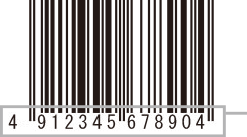What are 2D codes?
Features of 2D codes
Large data capacity
Barcodes contain data only in one direction while 2D codes contain data in both horizontal and vertical directions, so they can hold much more data than standard barcodes.
Barcodes contain up to 30 characters, but 2D codes can contain up to 3000 characters.

- A
- contains date horizontally
- B
- contains date vertically
High data density (Space-saving)
2D codes can be as small as 1/30th the size of a typical barcode containing the same data.
As a result, 2D codes can be printed on electronics and other small parts where space is limited.
2D codes offer error correction / data restoration
2D codes feature built-in error correction, allowing them to restore data if the code is damaged or smudged.
Mathematical error correction (Reed-Solomon) is employed for data restoration.
Disadvantage of 2D codes
2D codes have no backup when the data is unreadable
Barcodes typically have readable characters at the bottom, in case barcodes are damaged/missing.
Operators read the characters and input the data with a keyboard so that it does not affect operations.
2D codes have a very large amount of data, so readable characters are not added. When the 2D code is too damaged for scanning, there is no means to read the data and that interferes with operations. (It is possible to add readable characters to 2D codes, but it is not realistic to let personnel type more than 100 characters.)
When you use 2D codes, you need to create a system that can provide measures when the 2D code is damaged.

Personnel can check and input the data
Different types of 2D codes
2D codes are classified into two types according to the structure.
Stack type
Sample
Conventional barcodes are vertically stacked.


The stack type is composed of several barcodes vertically stacked in a rectangle.
General laser scanners can read the stack type if the laser crosses all stacked barcodes. However, it cannot tolerate displacement more than ±10°.
(Only laser scanners with software to read 2D codes can read 2D codes.)
Matrix type
Sample
Data is composed of black and white modules in a complex pattern.



The matrix type is composed of small squares or points called “modules” arranged in a square grid. They have a square frame, an L-shaped frame or position detection patterns for reliable position detection. A camera or a reader integrated with 2D CCDs decodes the module arrangement by image processing. It can be read from any direction.



